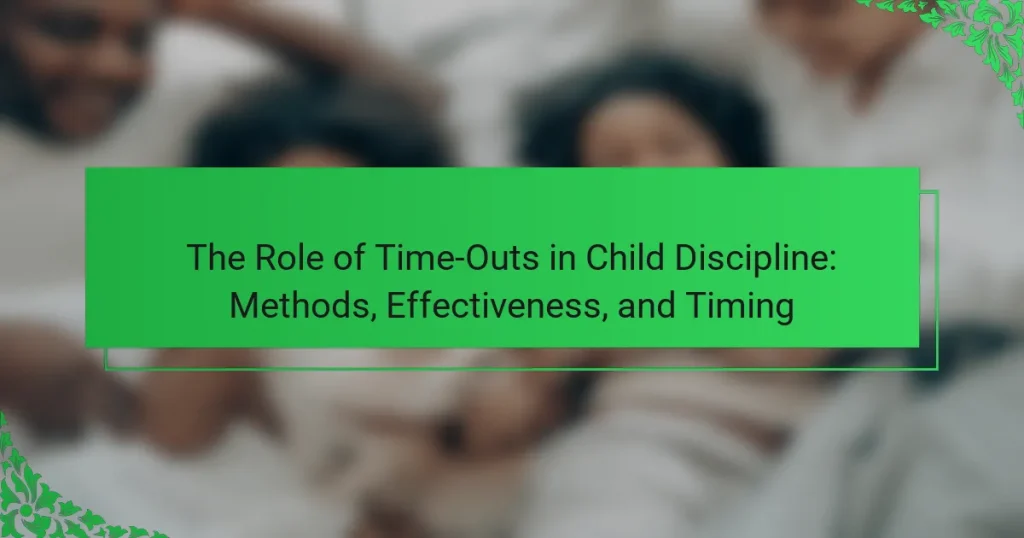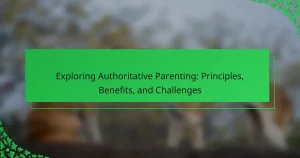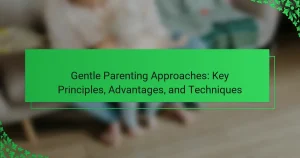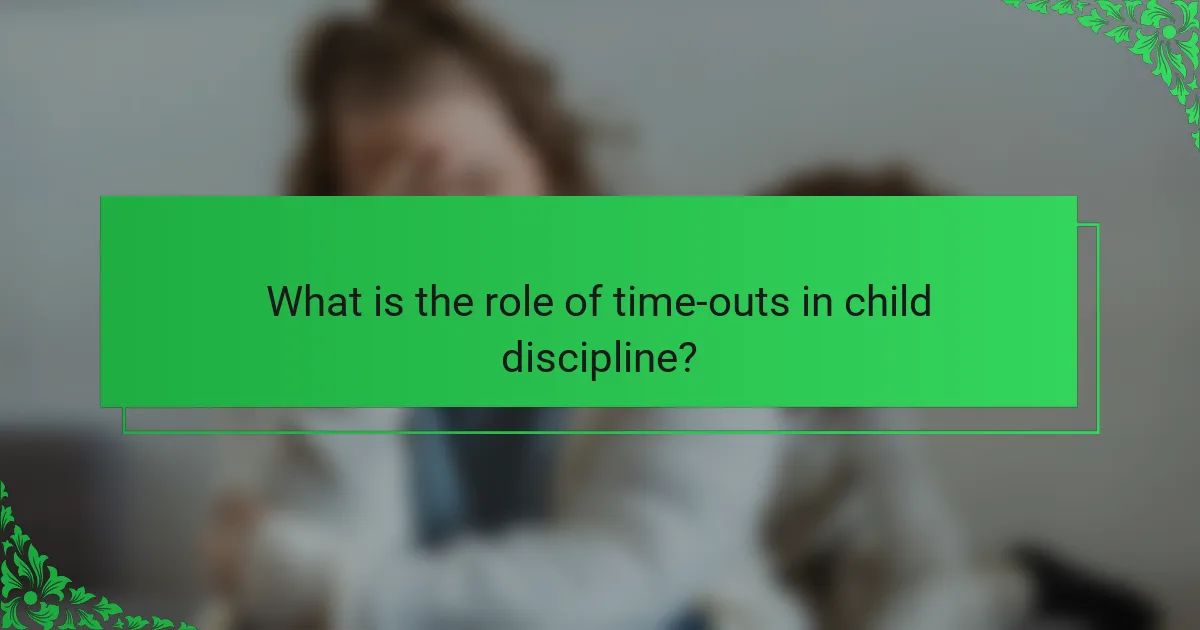
What is the role of time-outs in child discipline?
Time-outs serve as a disciplinary technique for managing children’s behavior. They provide a structured break from a situation where inappropriate behavior occurs. During a time-out, a child is removed from the environment to reflect on their actions. This method aims to reduce immediate disruptive behavior and promote self-regulation. Research indicates that time-outs can be effective when used consistently and in an age-appropriate manner. According to the American Academy of Pediatrics, time-outs help children understand the consequences of their actions. They also offer parents a moment to regain composure and address the child’s behavior constructively.
How are time-outs defined in the context of child discipline?
Time-outs are defined as a disciplinary technique used to manage a child’s behavior. This method involves temporarily removing the child from a situation to help them calm down. Time-outs aim to give the child a chance to reflect on their actions. Typically, this practice is implemented in a designated area, often away from distractions. Research indicates that time-outs can be effective in reducing inappropriate behaviors. The American Academy of Pediatrics supports time-outs as a valid strategy when used appropriately. Effective time-outs are brief and age-appropriate, lasting one minute for each year of the child’s age.
What are the key characteristics of effective time-out strategies?
Effective time-out strategies are characterized by clear rules, consistency, and a defined duration. Clear rules help children understand the behaviors that lead to a time-out. Consistency in applying these rules reinforces their importance. A defined duration, typically 1 minute per year of age, ensures that the time-out is appropriate and manageable. The environment should be safe and free from distractions. Additionally, time-outs should be followed by a discussion about the behavior and alternatives. Research indicates that these characteristics enhance the effectiveness of time-outs in child discipline.
How do time-outs differ from other disciplinary methods?
Time-outs differ from other disciplinary methods by focusing on removing a child from a situation to reflect on their behavior. This method emphasizes a short period of separation rather than punishment. Other methods may include verbal reprimands, physical consequences, or rewards for positive behavior. Time-outs are typically non-violent and aim to promote self-regulation. Research indicates that time-outs can help children develop emotional control by allowing them to calm down. In contrast, punitive methods may escalate conflict and create fear. Studies show that time-outs can be effective when used appropriately, fostering a child’s understanding of acceptable behavior.
Why are time-outs considered a valuable tool in parenting?
Time-outs are considered a valuable tool in parenting because they provide children with a chance to calm down and reflect on their behavior. This technique helps children learn self-regulation and understand the consequences of their actions. Research indicates that time-outs can be effective in reducing negative behaviors. A study published in the “Journal of Family Psychology” found that children who experienced consistent time-outs showed improved behavior over time. Time-outs also allow parents to maintain control and set clear boundaries. This method encourages children to think about their actions in a structured environment.
What psychological principles support the use of time-outs?
Time-outs are supported by several psychological principles, including behavior modification and emotional regulation. Behavior modification principles suggest that removing a child from a stimulating environment can decrease undesirable behaviors. This aligns with the concept of negative reinforcement, where the removal of an aversive stimulus can lead to a decrease in misbehavior. Emotional regulation principles indicate that time-outs provide children with an opportunity to calm down and reflect on their actions. Research by Kazdin (2005) shows that time-outs can effectively reduce aggression and improve self-control in children. Additionally, time-outs promote the understanding of consequences, reinforcing the link between actions and outcomes.
How do time-outs promote behavioral change in children?
Time-outs promote behavioral change in children by providing a structured period for reflection and self-regulation. During a time-out, children are removed from stimulating environments. This separation allows them to calm down and think about their actions. Research indicates that time-outs can help children understand the consequences of their behavior. A study published in the Journal of Child Psychology and Psychiatry found that children who experienced consistent time-outs showed improved compliance and reduced aggression. By associating negative behavior with a temporary loss of privileges, children learn to modify their actions. Overall, time-outs serve as an effective tool for teaching self-control and accountability.
What are the potential drawbacks of using time-outs?
Potential drawbacks of using time-outs include emotional distress for the child. Time-outs can lead to feelings of abandonment or rejection. This emotional response may hinder the child’s understanding of the intended lesson. Research indicates that frequent use of time-outs can create anxiety or resentment. Additionally, time-outs may disrupt the parent-child relationship. They can also result in a lack of communication about behavior. In some cases, time-outs may not effectively change the undesired behavior. Instead, they could reinforce negative behavior if not followed by constructive dialogue.
What negative effects can time-outs have on a child’s emotional well-being?
Time-outs can have several negative effects on a child’s emotional well-being. They may lead to feelings of abandonment or rejection when a child is isolated. This can foster anxiety and fear, particularly if the child perceives the time-out as a punishment rather than a teaching moment. Additionally, frequent time-outs can damage the parent-child bond, as the child may feel less connected to the caregiver. Emotional distress can result from repeated feelings of shame or guilt during time-outs. Research indicates that these experiences can hinder emotional regulation skills, making it harder for children to manage their feelings effectively. A study published in the journal “Child Development” highlighted that children subjected to punitive discipline, including time-outs, exhibited increased levels of aggression and decreased empathy. These findings suggest that while time-outs are intended to correct behavior, they may inadvertently harm a child’s emotional health.
How can improper use of time-outs lead to adverse outcomes?
Improper use of time-outs can lead to adverse outcomes such as increased aggression and anxiety in children. When time-outs are used excessively or inconsistently, children may feel confused about expectations. This confusion can result in a lack of understanding of acceptable behavior. Additionally, if time-outs are administered in a punitive manner, they can damage the parent-child relationship. Research indicates that children who experience harsh disciplinary methods are more likely to exhibit behavioral problems. Furthermore, improper timing of time-outs can disrupt emotional regulation, leading to heightened distress. Ultimately, these outcomes can hinder a child’s social and emotional development.

What methods can be used for implementing time-outs effectively?
Effective time-out methods include clear communication, consistent application, and appropriate duration. Parents should explain the reason for the time-out before it occurs. This helps the child understand the behavior that led to the consequence. Consistency in applying time-outs reinforces the rules. Each instance should follow the same procedure to avoid confusion. The duration of the time-out should be age-appropriate, typically one minute for each year of age. This guideline helps maintain effectiveness without overwhelming the child. Additionally, selecting a neutral location for the time-out minimizes distractions. This space should be devoid of stimulating items. Finally, it is essential to follow up with the child after the time-out. Discussing the behavior and reinforcing positive actions can foster understanding and growth.
What are the best practices for administering time-outs?
Best practices for administering time-outs include ensuring consistency, clarity, and appropriate duration. Time-outs should be used as a consequence for specific behaviors. Parents should clearly explain the reason for the time-out beforehand. The designated time-out area should be safe and free from distractions. A duration of one minute per year of the child’s age is recommended. After the time-out, parents should discuss the behavior with the child. Reinforcing positive behavior after the time-out is essential. Research indicates that consistent application of time-outs can lead to improved behavior over time.
How long should a time-out last for different age groups?
For children aged 2 to 3 years, a time-out should last 1 to 3 minutes. This duration aligns with the general guideline of one minute for each year of age. For preschool-aged children, ages 4 to 5, a time-out can extend to 3 to 5 minutes. This allows them to reflect on their behavior while being developmentally appropriate. For children aged 6 to 8 years, time-outs can last 5 to 10 minutes. This age group can handle longer periods of reflection. For preteens and teens, ages 9 and up, time-outs may last 10 to 20 minutes. Research supports these durations as effective for promoting self-regulation and understanding consequences.
What environment is most conducive to effective time-outs?
A quiet and distraction-free environment is most conducive to effective time-outs. This setting allows children to reflect on their behavior without external stimuli. A calm atmosphere reduces anxiety and promotes self-regulation. Research indicates that children benefit from a space that feels safe and non-threatening. An environment with minimal noise and interruptions fosters better emotional processing. Consistent use of the same location for time-outs can enhance their effectiveness. The predictability of the setting reinforces the purpose of the time-out.
How can parents prepare their children for time-outs?
Parents can prepare their children for time-outs by explaining the concept clearly. They should discuss what a time-out is and why it is used. This helps children understand the purpose behind the discipline method. Parents can set clear expectations regarding behavior to avoid confusion. They should also establish a consistent time-out location that is calm and free from distractions. Practicing calmness during discussions about time-outs can help children feel secure. Additionally, parents can role-play scenarios to help children anticipate time-out situations. Research shows that preparation can reduce anxiety and improve compliance during time-outs. Such proactive strategies create a supportive environment for children.
What communication strategies can help children understand time-outs?
Clear communication strategies can help children understand time-outs. Use simple language to explain what a time-out is. Describe it as a break for them to calm down. Explain the reasons for the time-out in a positive manner. Use examples they can relate to, like needing a break from a game. Discuss the expected behavior after the time-out. Reinforce that time-outs are not a punishment but a chance to think. Encourage children to express their feelings about the time-out. Regular discussions about emotions and behavior can enhance their understanding.
How can parents set clear expectations regarding behavior?
Parents can set clear expectations regarding behavior by communicating specific guidelines. They should define acceptable and unacceptable behaviors clearly. Consistency in enforcing these guidelines is essential. Parents can use positive reinforcement to encourage desired behaviors. Regular discussions about expectations can help reinforce understanding. Modeling appropriate behavior is also effective. Research indicates that children respond well to clear, structured environments. Studies show that consistent expectations lead to better behavioral outcomes in children.
What variations of time-outs exist?
There are several variations of time-outs used in child discipline. These include the traditional time-out, where a child is removed from a situation for a set period. Another variation is the positive time-out, which allows a child to take a break in a designated safe space to calm down. The time-in approach focuses on staying close to the child while they process their emotions, promoting connection instead of isolation.
Additionally, there is the non-verbal time-out, where a child is given space without verbal instructions, allowing them to reflect independently. Each method serves different purposes and can be effective depending on the child’s needs and behavior. The effectiveness of these variations can be influenced by factors such as the child’s age and temperament.
What is the difference between a planned time-out and a spontaneous time-out?
A planned time-out is a pre-arranged break from a situation, while a spontaneous time-out occurs unexpectedly. Planned time-outs are typically used as a strategy to manage behavior, allowing both the child and caregiver to prepare for the break. This method often includes discussing the reasons for the time-out beforehand. In contrast, spontaneous time-outs are implemented in reaction to immediate behavior issues. They are often unanticipated and can happen without prior discussion. Research shows that structured approaches, like planned time-outs, can lead to better behavioral outcomes compared to reactive methods.
How do different types of time-outs impact child behavior?
Different types of time-outs can significantly impact child behavior in various ways. Research indicates that time-outs can teach children self-regulation and appropriate behavior. For example, a study published in the Journal of Abnormal Child Psychology found that structured time-outs led to reductions in aggressive behavior among children.
There are generally two types of time-outs: “quiet time” and “social withdrawal.” Quiet time allows a child to calm down in a designated space, which promotes reflection. Social withdrawal, where a child is removed from a social setting, can emphasize the consequences of their behavior.
The effectiveness of these methods can vary based on the child’s age and temperament. Younger children may respond better to quiet time, while older children may understand the implications of social withdrawal. A study by the American Psychological Association highlighted that consistent application of time-outs leads to improved behavior over time.
Overall, the type of time-out employed influences how effectively a child learns from the experience.
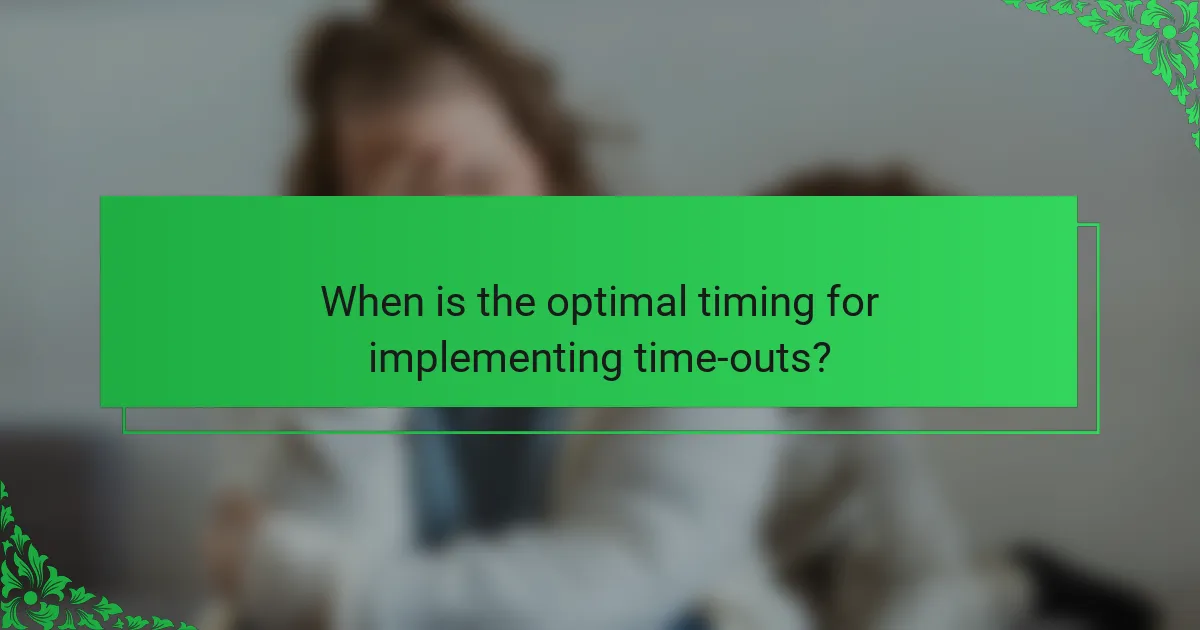
When is the optimal timing for implementing time-outs?
The optimal timing for implementing time-outs is immediately following inappropriate behavior. This approach helps children connect their actions with the consequences. Time-outs should be brief, typically lasting one minute for each year of the child’s age. Research indicates that immediate consequences reinforce learning. Delaying a time-out may confuse the child about what behavior is being addressed. Consistency in timing is crucial for effectiveness. Studies show that timely interventions lead to better behavior modification outcomes.
What situations warrant the use of a time-out?
Time-outs are warranted in situations where a child exhibits disruptive or aggressive behavior. This includes instances of hitting, yelling, or throwing objects. Time-outs can also be effective when a child is unable to calm down after repeated warnings. Additionally, they are appropriate when a child is not following rules or instructions. Research indicates that time-outs help children understand the consequences of their actions. They provide a break for both the child and the caregiver. This approach can lead to improved behavior over time.
How can parents identify the right moment for a time-out?
Parents can identify the right moment for a time-out by observing their child’s behavior. Signs include escalating tantrums, aggression, or inability to calm down. A time-out can be effective when a child is overwhelmed or acting out. It is important to act before the behavior worsens. Parents should also consider the child’s age and understanding of consequences. Research shows that consistent application of time-outs can lead to improved behavior. Timing is crucial; a time-out should occur immediately after inappropriate behavior to reinforce learning.
What role does a child’s emotional state play in timing time-outs?
A child’s emotional state significantly influences the effectiveness of time-outs. When a child is upset or angry, they may not comprehend the purpose of the time-out. Emotional distress can hinder their ability to reflect on their behavior. Research indicates that children in a heightened emotional state may not learn from the experience. A calmer emotional state allows for better understanding and processing of the situation. Timing a time-out when a child is emotionally regulated enhances its effectiveness. Studies show that children benefit more from time-outs when they are in a neutral emotional state. Therefore, assessing a child’s emotional condition before implementing a time-out is crucial for its success.
How can parents adjust the timing of time-outs based on effectiveness?
Parents can adjust the timing of time-outs by observing their child’s behavior and responses. Effective time-outs typically last between 1 to 5 minutes, depending on the child’s age. For younger children, shorter time-outs are more effective. Parents should increase the duration if the child does not show signs of understanding the behavior that led to the time-out.
Monitoring the child’s emotional state during the time-out is crucial. If a child remains upset, a shorter duration may be beneficial. Conversely, if a child reflects calmly, a longer time-out can reinforce the lesson. Research indicates that consistency in timing enhances the effectiveness of time-outs. Adjusting based on individual responses ensures that time-outs serve as a constructive discipline tool.
What signs indicate that a time-out is working?
Signs that indicate a time-out is working include a child’s calmness after the period of separation. The child may show reduced agitation or frustration. Another sign is the child’s willingness to engage in positive behavior after the time-out. This can include apologizing or expressing understanding of their previous actions. A decrease in negative behaviors over time also suggests effectiveness. Research indicates that consistent use of time-outs can lead to improved self-regulation in children. These signs collectively demonstrate that the time-out strategy is having a positive impact on the child’s behavior.
How can parents modify time-out strategies if they are ineffective?
Parents can modify ineffective time-out strategies by adjusting the duration and environment of the time-out. Shortening the time-out period may help maintain the child’s understanding of the consequence. Additionally, changing the location to a less distracting area can enhance the effectiveness. Parents should also ensure that the time-out is applied consistently to reinforce its purpose. Using a calm and clear explanation of the reason for the time-out can aid comprehension. Furthermore, incorporating positive reinforcement for good behavior can complement the time-out strategy. Research indicates that consistency and clarity are key factors in the effectiveness of discipline methods.
What practical tips can help parents use time-outs effectively?
To use time-outs effectively, parents should follow specific strategies. First, choose a designated time-out spot that is safe and free from distractions. This helps children understand the purpose of the time-out. Next, explain the reason for the time-out clearly and calmly. This ensures children comprehend their behavior’s consequences.
Timing is crucial; implement time-outs immediately after inappropriate behavior for maximum impact. The duration should be age-appropriate, typically one minute for each year of the child’s age. Consistency is essential; use time-outs for similar behaviors to reinforce learning.
After the time-out, discuss the behavior with the child. This conversation reinforces understanding and encourages better choices in the future. Finally, offer praise when the child exhibits positive behavior after the time-out. This reinforces the desired behavior and promotes a positive relationship.
The primary entity of this article is time-outs as a disciplinary technique in child discipline. The article examines the role, definition, and effectiveness of time-outs, highlighting their characteristics, differences from other methods, and psychological principles that support their use. It discusses best practices for implementing time-outs effectively, including optimal timing, environmental considerations, and communication strategies. Additionally, the article addresses potential drawbacks and variations of time-outs, providing practical tips for parents to enhance their effectiveness in promoting behavioral change in children.
